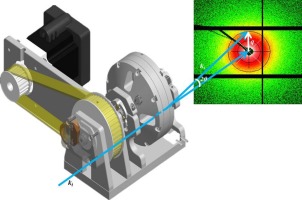When being turned into consumer food products, the structure of the raw materials changes during processing. A common occurrence is shear, when a strain is produced by layers of a substance shifting sideways in relation to each other. It is important to understand these structural changes when considering how to improve food production to make it more sustainable, and to make the food itself tastier.
The focus of this experiment was calcium caseinate: a protein derived from the casein in milk. The food industry commonly uses it in powders that require quick dispersion in water, such as instant cream soups.
Small-angle scattering of X-rays (SAXS) and neutrons (SANS) is widely utilized to study structures of food materials, as the accessible length scales correlate well with the structural dimensions of food systems. These techniques have been applied while the materials are under shear, or flow, conditions before, but so far there has not been a cell that can be used for both SAXS and SANS.
A group of researchers from Delft University of Technology and Unilever has designed and built a versatile and compact shear cell to perform both SAXS and SANS measurements. Through experiments on the LARMOR instrument at ISIS, and the DUBBLE beamline at ESRF, they applied this new design of shear cell to studies of food materials.
Being able to use neutrons and X-rays to monitor a sample enables scientists to build a more comprehensive picture of the changes that are happening to the structure of the material. The researchers wanted to be able to perform experiments on complex fluids under the same conditions in a cell that was suitable for both types of radiation. To make the cell suitable for both X-rays and neutrons, special types of windows were necessary for each type of radiation.
 A schematic 3D drawing of the developed shear-cell, with 2D SAXS pattern.
A schematic 3D drawing of the developed shear-cell, with 2D SAXS pattern.
Since the structure of food, and how it changes, is highly dependent on the temperature of the material, they also included a special housing for temperature control in their design.
An in situ experiment was carried out on the LARMOR instrument at ISIS, investigating the structuring of calcium caseinate protein dispersions under shear using neutron scattering. They found that, surprisingly, the scattering pattern obtained at a shear rate as high as 100 s−1 overlapped perfectly with that taken of the original sample, indicating that shear had no influence on the sample structure at the length scale studied.
The cell was tested in another in situ experiment, which took place at the DUBBLE beamline at ESRF. For this, it was used in combination with X-ray scattering for investigation of cellulose dispersions and fat crystal dispersions.
STFC's technology for improving food security
This feature article for World Food Day 2018 illustrates how cutting-edge research at STFC's ISIS Neutron and Muon Source and Central Laser Facility is revolutionising what we know about food science and paving the way for future global food security.
The STFC Food Network+ connects one of the UK's leading science communities directly into the challenge of creating sustainable food production systems. It brings together STFC researchers and facilities with research and industry in the agri-food sector.
Further information
Find out more about Larmor and the permanently installed Spin-Echo SANS (SESANS) setup developed by the Delft University of Technology (Netherlands) here.
This research was published in Colloids and Surfaces A: Physicochemical and Engineering Aspects.
